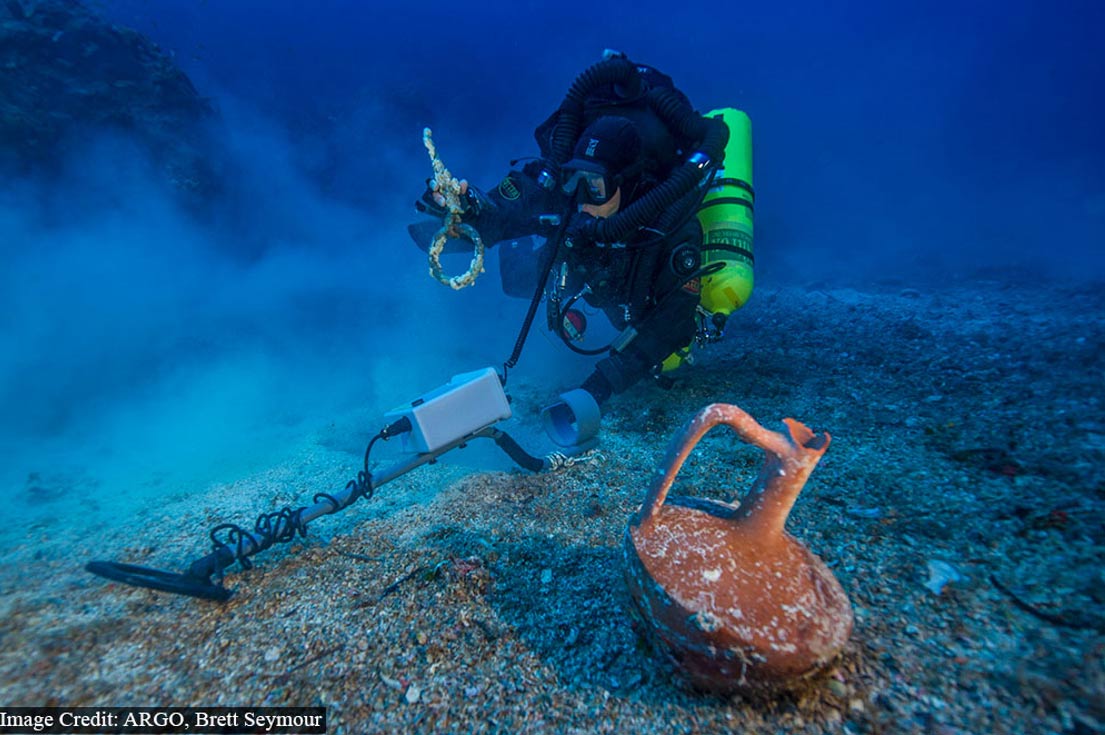The Antikythera Shipwreck – The Titanic of the Ancient World and its Sunken Historic Treasure
Some of the world’s greatest archaeological discoveries have been uncovered by chance. The terracotta warriors, for instance, were first discovered in 1974 by Chinese farmers who were digging for a well. Likewise was the discovery of the Antikythera Shipwreck, dubbed recently the ‘ Titanic of the Ancient World’.
In October 1900, a group of Greek sponge divers were returning from North Africa when they ran into a severe storm. At the island of Antikythera, the divers anchored their boat, and waited for the storm to subside. While on Antikythera, some of the crew decided to dive along the island’s coastline in search of clams for a meal. One of the divers, Ilias Stadiatis, stumbled upon something far more remarkable – the remains of a ship that laid at a depth of between 42 and 50 meters under the sea. Stadiatis even brought an arm from a bronze statue from the wreck to his companions, who must have been quite amazed at this discovery.
In the following month, the captain of the boat, Dimitrios Kontos, alerted the authorities in Athens about the discovery of the shipwreck. Officials wasted no time, and Mykali, a vessel of the Hellenic Royal Navy, was sent to Antikythera to aid recovery operations. Later, the civilian steamship Syros, and the Navy’s torpedo boat, Aigialeia, were also sent to the island.
Over the next couple of months, Greek divers made a great effort to salvage the wreck. At that time, the standard diving equipment was a thick canvas suit and copper helmet. The divers salvaging the Antikythera Shipwreck had only one of these suits to share, and each diver only dived for ten minutes, twice a day.
MORE
- New analysis of Antikythera Mechanism reveals clues to one of history’s greatest puzzles
- Researchers to revisit ancient Antikythera wreck using new technology
- Daring new search of ancient Antikythera wreck begins today
- Uluburun, one of the oldest and wealthiest shipwrecks ever discovered
At the end of the mission in September 1901, only five men were still fit to dive. Two men were paralyzed as a result of decompression sickness, and another unfortunately lost his life. Through the efforts and sacrifice of these divers, many artifacts, including a number of bronze and marble statues, glassware, and amphorae were brought to the surface, and then sent to the National Archaeological Museum of Athens.
One of the most significant finds of the Antikhythera Shipwreck is an object now known as the Antikhythera mechanism, described as the world’s first analog computer.

The amazing Antikythera Mechanism found in a shipwreck off the island of Antikythera in Greece. Credit: Tilemahos Efthimiadis / flickr
Due to the dangers of diving at such depths and the lack of more sophisticated equipment, the salvage operation could not continue. It was only in 1953, and again in 1976, that the famed French explorer Jacques-Yves Cousteau briefly visited the site of the Antikythera Shipwreck.
In 1953, Cousteau and his team were at the site for only three days, though that sampling was enough to bring him back in 1976 to film the ‘Diving for Roman Plunder’ episode of his 1970s documentary series, The Cousteau Odyssey.
Apart from these two intervals, the site remained undisturbed for decades. Although no further explorations were carried out, there were enough artifacts from the site for archaeologists to date the wreck. While some of the bronze statues were dated to the fourth century B.C., and some of the marble statues were first century B.C. copies of earlier ones, it was through the carbon dating of the ship’s wood that yielded it age, giving a calibrated calendar date of 220 B.C. ± 43 years. Based on other observations, however, it has been demonstrated that the ship only sank sometime in the first century B.C., perhaps some two centuries after it was built.

Representatives of the Greek government, the crew and the sponge divers on the deck of the Greek navy ship Mykali in winter 1900/1901, pulling up objects from the Antikythera shipwreck (Wikimedia).
It was only in September 2014 that investigation of the Antikythera Shipwreck resumed under the ‘Return to Antikythera’ project. Armed the latest technology, the research team is set on unlocking the secrets of the wreck. Using mixed gas closed circuit rebreathers and the Exosuit, the divers of this project are in a much safer position than their predecessors. An autonomous robot carrying stereocameras and sonar was employed to map the site.
The team has already met with success, obtaining evidence which suggest that the ship was 50 meters long, much larger than previously thought, thus earning the nickname the ‘Titanic of the ancient World’.
With further investigation, what more will we learn about the Antikythera Shipwreck?

Exosuit (robot exo-suit with human operator inside) developed by Nuytco research. Credit: American Museum of Natural History
Featured image: Metal detector survey of the shipwreck area, photo by Brett Seymour. Photo source: antikythera.whoi.edu.
References
Dvorsky, G., 2014. Archaeologists Make Stunning Discoveries at the Antikythera Shipwreck. [Online]
Available at: http://io9.com/archaeologists-make-stunning-discoveries-at-the-antikyt-1644816754
Pruitt, S., 2014. Divers Excavate Greek Shipwreck Dubbed “Ancient Titanic”. [Online]
Available at: http://www.history.com/news/divers-excavate-greek-shipwreck-dubbed-ancient-titanic
Woods Hole Oceanographic Institution, 2014. Return to Antikythera. [Online]
Available at: http://antikythera.whoi.edu/
www.bbc.com, 2014. Antikythera wreck yields new treasures. [Online]
Available at: http://www.bbc.com/news/science-environment-29557384
www.sci-news.com, 2014. Archaeologists Find More Artifacts at Antikythera Shipwreck. [Online]
Available at: http://www.sci-news.com/archaeology/science-antikythera-shipwreck-02201.html
Zolfagharifard, E., Woollaston, V. & Prigg, M., 2014. Return to Antikythera dive unearths new treasures: Ceramic jug and spears are among the latest finds from the shipwreck dubbed ‘Titanic of the ancient world’. [Online]
Available at: http://www.dailymail.co.uk/sciencetech/article-2786434/Search-ancient-underwater-computer-begins-Archaeologists-wear-Exosuit-rummage-2-200-year-old-shipwreck.html
By Ḏḥwty



















